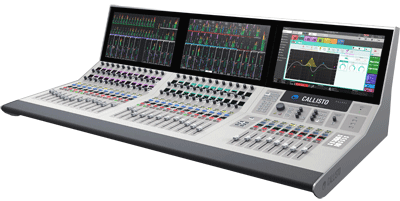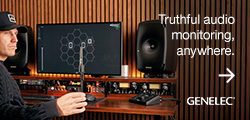 Targetting live broadcasters that do not require the full resources of the Apollo and Artemis consoles, Calrec has announced Callisto: ‘Throughout the design process, we’ve kept the focus not just on features and capabilities, but on the totality of the user experience,’ says Head of Sales, Henry Goodman. ‘We’ve kept the user interface simple and straightforward
Targetting live broadcasters that do not require the full resources of the Apollo and Artemis consoles, Calrec has announced Callisto: ‘Throughout the design process, we’ve kept the focus not just on features and capabilities, but on the totality of the user experience,’ says Head of Sales, Henry Goodman. ‘We’ve kept the user interface simple and straightforward
Callisto’s mechanical design keeps components and materials to a minimum. Disciplined power distribution means the console is around 30 per cent more efficient than a comparable Artemis Light (Callisto’s closest stablemate) and service access is from the front of the console – the entire control surface can be replaced by removing just 12 screws.
Callisto’s intuitive GUI is designed to be suited to a broad range of operator levels. Users control the console via a 17-inch multitouch screen inspired by tablet technology, with a straightforward interface that uses established finger gestures to navigate the system. A high-resolution display provides both controls and clear presentation of information and complex workflow tasks, such as creating mix-minus feeds, use common procedures that places them one tap away.
Callisto’s other large displays are fully configurable to display bus, output and loudness meters, and feature dedicated metering, routing and processing information per fader.
The physical control surface is available in fixed 32- and 44-fader configurations with a new streamlined layout. Each channel strip has only the most essential mechanical controls, featuring a fader, two flexible control cells, and a dedicated gain pot.
Callisto uses Calrec’s Bluefin2 technology at its core, and the same integral 8192 x 8192 Hydra2 router as the Apollo and Artemis consoles. Bluefin2 and Hydra2 technologies are in use 24 hours a day at hundreds of facilities across the globe, and are still the most advanced audio processing technologies available.
Bluefin2 provides Callisto with a pool of 180 channel processing paths, which can be assigned as mono, stereo or 5.1 channels. As with all Calrec consoles, there is no resource-sharing across the DSP, so all facilities are available on all channels at all times. Callisto has eight groups, four mains (all of which can be mono, stereo, or 5.1), 16 auxes, and 32 tracks.
The broadcast-focused feature set also includes complete system redundancy, dedicated delay on all paths with additional assignable input and output delay, mechanical PFL overpress on all faders,and three 5.1 studio monitor outputs.
More: www.calrec.com










